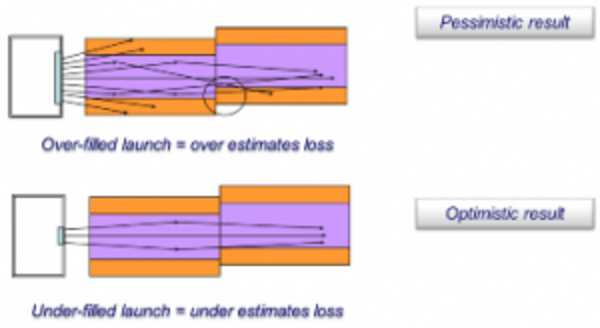Standards spend a lot of effort developing and improving test methods for all types of cabling. What would be the point of having performance requirements if there was not a uniform way to test for them? For multimode optical fiber cabling, encircled flux (EF) is the latest improvement to be made for evaluating the loss performance of cable and assemblies in the factory. Incorporated into both IEC 61280-4-1 Ed. 2.0 and TIA-526-14-B, EF is a specification on the power distribution of light within the fiber core. To match an active source output, there cannot be too much light at either the edges (over-filled) or core (under-filled) of the output of the launch cord.
Some misunderstand EF to be a compromise between LED and VCSEL testing. The truth is that the encircled flux metric was based on obtaining the most repeatable measurements when evaluating typical ‘critical’ data links of the sort that would be used for applications seen and designed for today, such as 10, 40, and 100G Ethernet. EF compliance reduces loss measurement variation to a goal of +/- 10%, reducing variability by up to 75% compared to the preceding standard.
A review ofIEC TR 61282-11can provide a much more in-depth look at the mathematics behind it. There were several key contributors to this technical report, and this is a great opportunity for us to recognize Bob Conte (of CommScope), who was awarded the IEC 1906 award for his contributions.
Key points to understand about EF testing are that it:
• Reduces link loss measurement variability
• Was developed to provide the higher precision necessary for properly assessing the low levels of allowed loss needed to support high speed multimode fiber networks (8G, 10G, 16G, 40G, and 100G applications using 850 nm VCSEL and OM3/4 fiber)
• Is defined for 850 nm and 1300 nm measurements of installed links and channels, as well as for cabling assemblies in the factory • Improves supplier to supplier consistency
• Is now standardized in both TIA and IEC
To achieve an EF-compliant launch may require a launch conditioning device that is different than the mandrel wrap previously prescribed by standards. Consult your test gear company for specifics. The picture below shows an EF mode conditioning device placed in line with the launch cord at both ends of a bi-directional fiber link test.
For more details on the testing of optical fiber systems, review Structured Connectivity Solutions Field Testing Guidelines For Fiber-Optic Cabling Systems for more details on encircled flux specifically, review Encircled Flux – The New Standard in Multimode Testing Accuracy from Fluke Networks
[Images courtesy of Fluke Networks]









